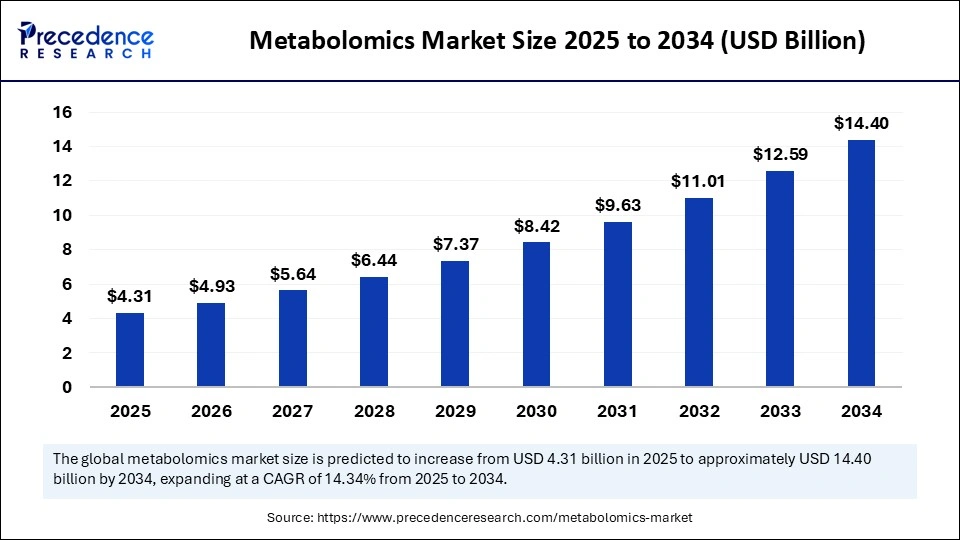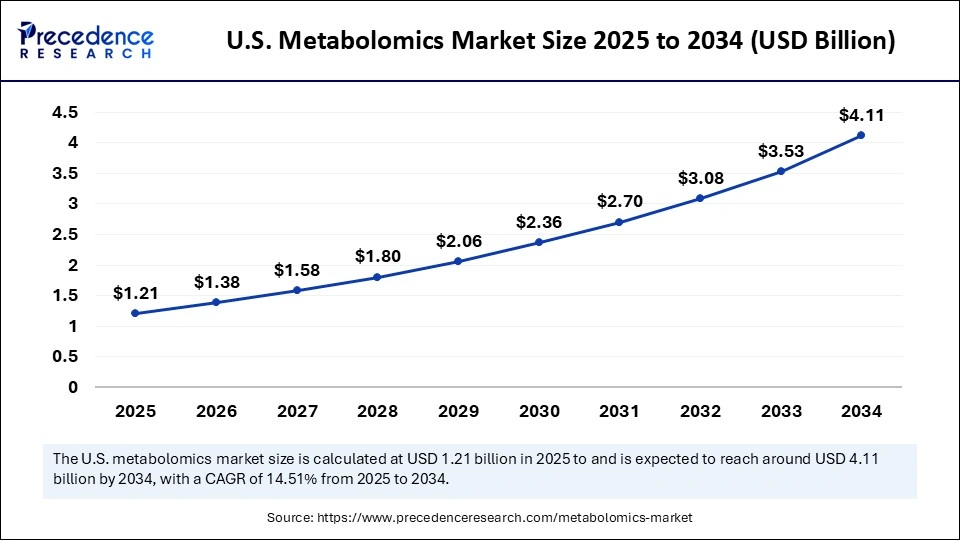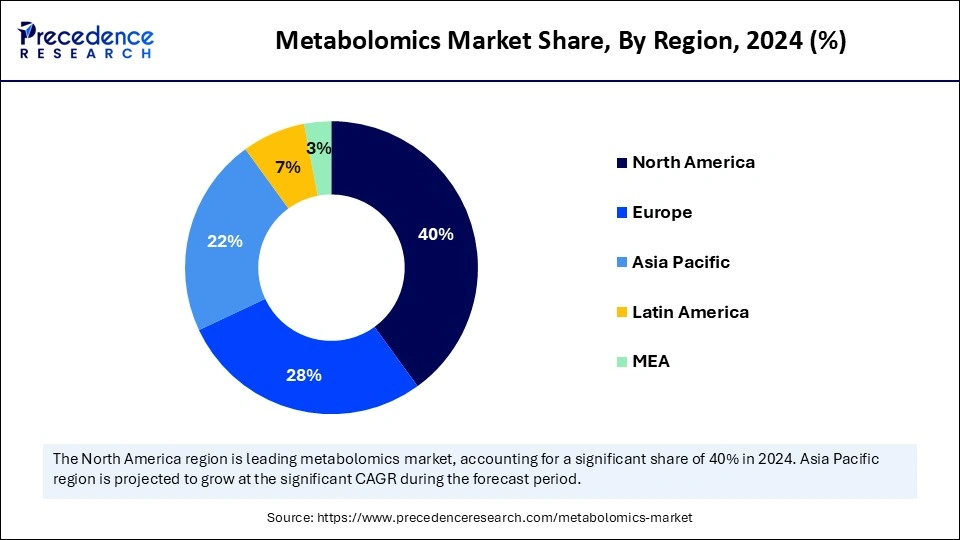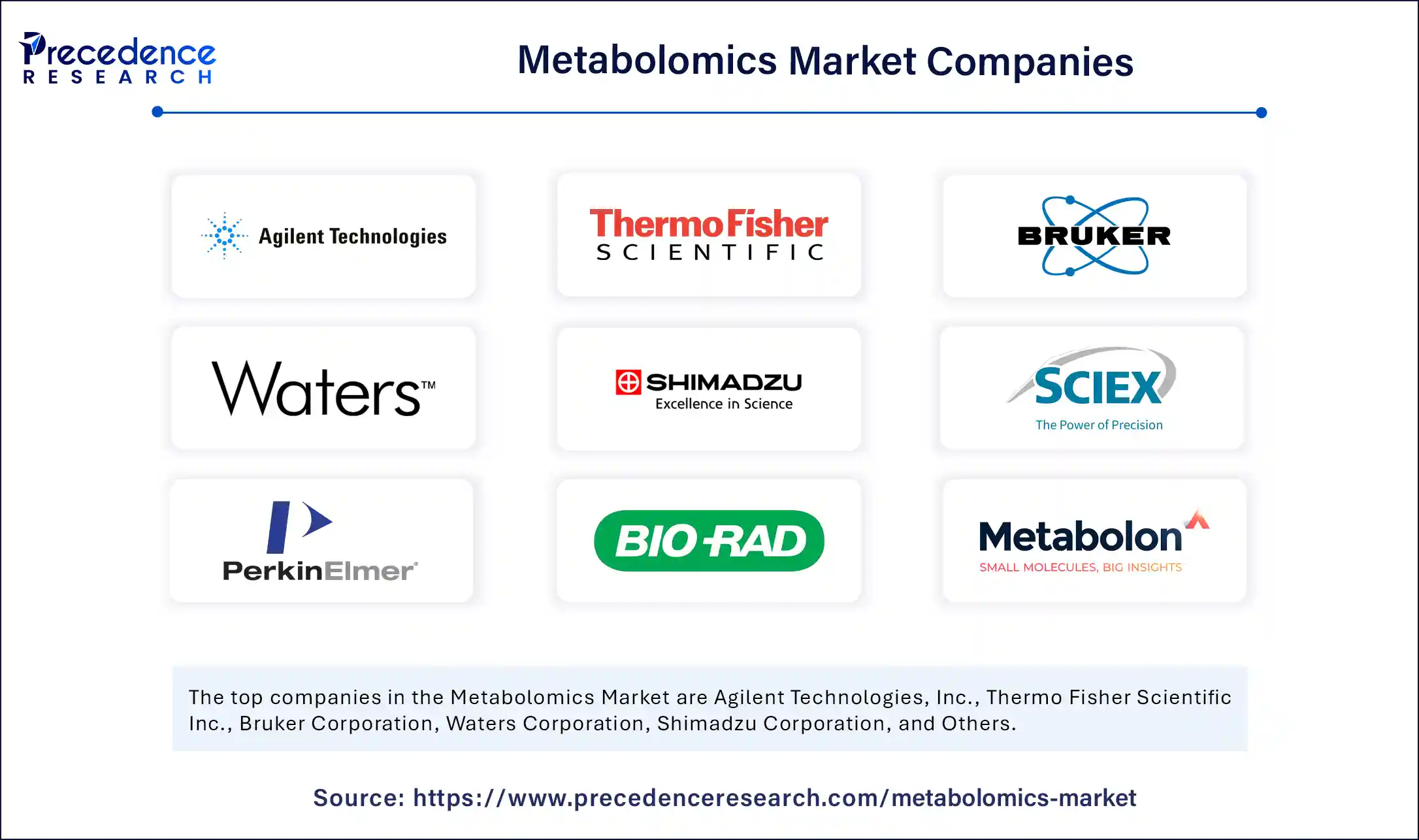List of Contents
Metabolomics Market Size and Forecast 2025 to 2034
The global metabolomics market size was calculated at USD 3.77 billion in 2024 and is predicted to increase from USD 4.31 billion in 2025 to approximately USD 14.40 billion by 2034, expanding at a CAGR of 14.34% from 2025 to 2034. The metabolomics market has experienced significant growth in recent years, reflecting the increasing reliance on digital platforms for freelance and gig-based work. As of 2024, the market size is estimated at USD 3.77 billion, with rapid expansion projected into the coming years. The metabolomics market is an emerging field of life science focused on the comprehensive study of metabolites within cells, tissues, and biofluids. It plays a critical role in understanding biochemical pathways and uncovering biomarkers.

Metabolomics Market Key Takeaways
- In terms of revenue, the global metabolomics market was valued at USD 3.77 billion in 2024.
- It is projected to reach USD 14.40 billion by 2034.
- The market is expected to grow at a CAGR of 14.34% from 2025 to 2034.
- North America dominated the metabolomics market with the largest market share of 40% in 2024.
- Asia Pacific is anticipated to grow at the fastest CAGR during the forecast period.
- By product and services, the instruments segment held the biggest market share in 2024.
- By product and services, the bioinformatics tools & services segment is expected to grow at the fastest CAGR during the forecast period.
- By application, the biomarker discovery segment led the market in 2024.
- By application, the personalized medicines segment is projected to experience the highest growth CAGR between 2025 and 2034.
- By study type, the targeted metabolomics segment captured the highest market share in 2024.
- By study type, the untargeted metabolomics segment is set to experience the fastest CAGR from 2025 to 2034.
- By indication, the oncology segment contributed the highest market share in 2024.
- By indication, the neurology services are the fastest growing from 2025 to 2034.
- By end-user, the pharmaceutical & biotechnology companies segment generated the major market share in 2024.
- By end-user, the diagnostic laboratories are the fastest growing from 2025 to 2034.
Mapping the Metabolome: A Market on the Rise
The metabolomics market refers to the comprehensive analysis of metabolites, which are small-molecule intermediates and products of metabolism, within cells, tissues, or biofluids. It provides critical insights into disease mechanisms, biomarker discovery, drug development, toxicology, and personalized medicine. By profiling metabolic changes, metabolomics enables researchers to identify early disease indicators, predict therapeutic responses, and enhance clinical diagnostics. The field leverages advanced platforms such as mass spectrometry (MS), nuclear magnetic resonance (NMR) spectroscopy, chromatography, and bioinformatics tools for data interpretation. Growth in this market is fueled by the rising demand for precision medicine, expanding pharmaceutical R&D, and increased application of metabolomics in nutrigenomics and microbiome studies. North America dominates, while the Asia Pacific is rapidly emerging with strong research investments.
The metabolomics market is experiencing significant growth driven by rising demand for precision medicine and biomarker discovery. Technological advancements in mass spectrometry, NMR spectroscopy, and bioinformatics are improving the speed and accuracy of metabolite profiling. Pharmaceutical and biotechnology companies are increasingly investing in metabolomics to accelerate drug development and reduce clinical trial costs. Academic research institutions are also adopting metabolomics to explore disease mechanisms and metabolic disorders. Despite its promise, the market faces challenges such as high instrument costs and data complexity. Nevertheless, the growing focus on personalized healthcare is expected to sustain strong market expansion in the coming years.
AI-Decoding Metabolomes with Smart Algorithms
Artificial intelligence is revolutionizing the metabolomics market by enabling rapid data processing, interpretation, and pattern recognition. AI-powered algorithms can handle massive, complex datasets generated from metabolomic studies more efficiently than traditional methods. Machine learning models are increasingly being used to identify disease-specific biomarkers and predict drug responses with greater accuracy. AI also enhances precision by reducing false positives in metabolite identification, thereby improving reliability. Furthermore, predictive analytics powered by AI supports personalized treatment planning and preventive care. As AI continues to integrate with metabolomics, it unlocks new insights and accelerates translational research.
U.S. Metabolomics Market Size and Growth 2025 to 2034
The U.S. metabolomics market size was exhibited at USD 1.06 billion in 2024 and is projected to be worth around USD 4.11 billion by 2034, growing at a CAGR of 14.51% from 2025 to 2034.

How North America is Leading the Metabolomics Frontier?
North America is leading the metabolomics market due to its strong research infrastructure and high investment in life sciences. The region hosts leading pharmaceutical and biotechnology companies actively integrating metabolomics into R&D. Academic and clinical research institutions also contribute significantly, supported by government funding for precision medicine. The presence of advanced healthcare systems accelerates clinical adoption of metabolomics-based diagnostics. Moreover, collaborations between academia and industry foster innovation and commercialization. With strong demand for personalized medicine, North America is expected to maintain its market leadership.

Is Asia Pacific Unlocking Untapped Potential?
Asia-Pacific is the fastest-growing region in the metabolomics market, driven by increasing investment in healthcare and research infrastructure. Countries like China, India, and Japan are rapidly adopting metabolomics for disease research and agricultural innovation. The rising prevalence of chronic diseases in the region is fueling demand for advanced diagnostics and biomarker discovery. Governments are also investing in genomics and multi-omics projects, creating fertile ground for the integration of metabolomics. Expanding collaborations with global pharmaceutical companies are accelerating technology transfer. With its large patient population and growing research capacity, the Asia-Pacific is emerging as a key growth hub for the metabolomics industry.
Market Key Trends
- Rising adoption of metabolomics in precision medicine and biomarker discovery.
- Integration of AI and machine learning into data analysis workflows.
- Increasing use of metabolomics in nutrition, toxicology, and environmental sciences.
- Growth in academic-industry collaborations for drug discovery applications.
- Expanding metabolomics applications in agriculture and food quality testing.
Market Scope
| Report Coverage | Details |
| Market Size by 2034 | USD 14.40 Billion |
| Market Size in 2025 | USD 4.31 Billion |
| Market Size in 2024 | USD 3.77 Billion |
| Market Growth Rate from 2025 to 2034 | CAGR of 14.34% |
| Dominating Region | North America |
| Fastest Growing Region | Asia Pacific |
| Base Year | 2024 |
| Forecast Period | 2025 to 2034 |
| Segments Covered | Product & Service, Application, Study Type, Indication, End User, and Region |
| Regions Covered | North America, Europe, Asia-Pacific, Latin America, and Middle East & Africa |
Market Dynamics
Drivers
Fueling Discovery: Precision Medicine at the Forefront
A key driver of the metabolomics market is the rising emphasis on precision medicine. As healthcare shifts toward more personalized approaches, metabolomics provides essential insights into individual metabolic profiles. This enables clinicians to identify disease risks, monitor treatment responses, and tailor therapies to meet the specific needs of individual patients. Pharmaceutical companies also leverage metabolomics to design more targeted drugs and reduce trial failures. Governments and funding agencies are increasingly supporting precision medicine initiatives, further boosting adoption. This focus on personalization is expected to remain a strong growth engine for the metabolomics market.
Restraint
High Investment, Limited Access
One of the biggest restraints in the metabolomics market is the high cost of instruments and technologies. Advanced tools like NMR spectroscopy and mass spectrometry require significant capital investments, making them less accessible to smaller research labs. Additionally, the operational complexity of these instruments demands skilled professionals, further raising costs. Data analysis also presents a challenge, as metabolomics generates vast datasets requiring sophisticated software and expertise. These barriers limit widespread adoption in developing regions and smaller institutions. Without cost-effective solutions, the growth potential of metabolomics may face constraints.
Opportunity
Beyond Healthcare Applications
The metabolomics market is witnessing growing opportunities beyond healthcare. Applications in agriculture, food science, and environmental monitoring are rapidly gaining traction. For instance, metabolomics can be used to enhance crop yields, detect contaminants, and ensure food safety. In environmental studies, it supports pollution monitoring and ecosystem health assessments. Nutrition and wellness industries are also exploring metabolomics for personalized diet recommendations. By diversifying into these areas, market players can capture new revenue streams and reduce reliance on biomedical applications. This cross-sector adoption represents a major growth opportunity for the metabolomics industry.
Product & Service Insights
Why Are Instruments Dominating the Metabolomics Market?
Instruments dominate the metabolomics market as they form the core tools required for metabolite analysis and profiling. Advanced technologies such as mass spectrometry, NMR spectroscopy, and chromatography are widely used for high-precision detection. These instruments enable researchers to obtain accurate, reproducible, and detailed measurements of metabolites. Pharmaceutical companies rely heavily on such tools for biomarker discovery and drug development. Academic institutions also invest in cutting-edge instruments to support fundamental research. The high demand for reliable and sophisticated instruments solidifies their dominance in the market.
The stronghold of instruments is also reinforced by continuous technological innovation. Manufacturers are improving sensitivity, throughput, and automation features to cater to complex research demands. Despite their high costs, instruments are indispensable, making them the foundation of metabolomics workflows. Collaborations between technology providers and research centers are accelerating adoption globally. Moreover, the need for validation in clinical and pharmaceutical settings ensures steady demand. This dominance will continue as instruments remain the primary enabler of metabolomics research.
Bioinformatics tools and services are the fastest-growing segment due to the immense complexity of metabolomics data. As metabolomic studies generate vast datasets, computational solutions are essential for accurate analysis. Bioinformatics platforms use algorithms, AI, and machine learning to identify, classify, and interpret metabolites. Researchers increasingly rely on these services to reduce analysis time and enhance precision. This demand is particularly high in multi-omics studies where integration of genomics, proteomics, and metabolomics data is required. The scalability of bioinformatics tools is driving their rapid adoption.
Growth is further fuelled by cloud-based platforms that provide remote accessibility and collaborative features. Service providers are offering customized solutions for drug discovery, diagnostics, and biomarker validation. The growing focus on AI-driven predictive analytics also enhances the importance of this segment. Unlike instruments, which face cost barriers, bioinformatics tools are more adaptable and scalable. Academic labs and start-ups find them cost-effective, further broadening the user base. This momentum ensures bioinformatics will remain the fastest-growing component of metabolomics.
Application Insights
Why Is Biomarker Discovery Dominating the Market?
Biomarker discovery dominates metabolomics applications due to its critical role in disease detection and therapeutic development. Metabolomic profiling helps identify molecular signatures linked to specific diseases. Pharmaceutical and biotech firms use biomarkers to improve clinical trial success rates and drug efficacy testing. Academic researchers also apply metabolomics in uncovering biomarkers for metabolic and chronic conditions. Regulatory bodies encourage biomarker use for precision diagnostics, fueling adoption. This broad applicability makes biomarker discovery the leading application segment.
The growing demand for early disease detection tools reinforces the dominance. Cancer, cardiovascular, and metabolic disorders particularly benefit from metabolomics-driven biomarkers. Emerging partnerships between research institutes and pharma companies are accelerating biomarker commercialization. Technological advances in mass spectrometry and bioinformatics further improve biomarker reliability. With healthcare shifting toward predictive medicine, biomarker discovery is expected to remain a central pillar. Its importance ensures continued leadership in the field of metabolomics applications.
Personalized medicine is an expanding application of metabolomics, offering patient-specific treatment strategies. By analyzing metabolic profiles, clinicians can determine how individuals respond to therapies. This helps optimize drug dosing, minimize side effects, and improve overall outcomes. The growing focus on precision healthcare worldwide is fueling adoption. Pharmaceutical firms are integrating metabolomics into R&D pipelines for targeted therapies. Personalized medicine thus represents a transformative application of metabolomics.
The growth of personalized medicine is further supported by rising chronic disease prevalence. Patients demand treatments tailored to their unique biology, rather than generalized protocols. Advances in computational biology and AI enhance the predictive power of metabolomics for personalized care. Academic centers and hospitals are integrating these approaches into clinical practice. Government and private funding for precision medicine initiatives also support expansion. This ensures personalized medicine will remain one of the fastest-rising applications of metabolomics
Study Type Insights
Why Did the Targeted Metabolomics Segment Registered Its Dominance Over the Metabolomics Market?
Targeted metabolomics dominates because it althe lows for precise quantification of known metabolites. Researchers use it to validate biomarkers, monitor specific pathways, and study drug effects. Its reliability and reproducibility make it highly valuable in clinical and pharmaceutical studies. This method is widely adopted due to its structured approach and ability to yield actionable results. Targeted metabolomics is particularly crucial in regulatory studies where accuracy is mandatory. Its precision ensures its leadership in the study type category.
The dominance of targeted metabolomics is reinforced by its integration into drug development pipelines. Pharmaceutical companies depend on it for safety assessments and mechanistic studies. Clinicians also apply it to confirm disease markers in diagnostics. While less exploratory than untargeted approaches, its accuracy is unmatched. Investments in advanced analytical tools continue to enhance its capabilities. As demand for clinical validation rises, targeted metabolomics will retain its stronghold.
Untargeted metabolomics is the fastest-growing segment due to its ability to explore the full metabolic landscape. Unlike targeted approaches, it identifies both known and unknown metabolites, making it ideal for discovery research. This exploratory power is crucial in identifying novel biomarkers and disease pathways. It is widely applied in nutrition, environmental studies, and early-stage drug discovery. The ability to generate new hypotheses is driving a strong interest. This makes untargeted metabolomics the most dynamic area of growth.
Advancements in data analytics and high-resolution instruments fuel the momentum. Researchers can now handle large-scale, complex datasets more efficiently. AI and machine learning are enhancing untargeted metabolomics by uncovering hidden patterns. Funding for exploratory biomedical research also supports this approach. Academic centers favor it for innovation and hypothesis generation. This ensures untargeted metabolomics continues to expand as the fastest-growing study type.
Indication Insights
Why Is Oncology Dominating the Metabolomics Market?
Oncology dominates metabolomics applications due to the urgent need for cancer biomarkers and therapies. Metabolite profiling helps detect cancer at early stages and monitor progression. Pharmaceutical companies rely on metabolomics to identify drug targets and evaluate treatment responses. Academic institutions focus heavily on cancer research, reinforcing adoption. With cancer being one of the leading global health burdens, oncology remains the top indication for metabolomics. Its life-saving potential drives its market leadership.
Rising investments in cancer research further support the dominance of oncology. Governments and private organizations are funding biomarker discovery projects. Clinical trials increasingly incorporate metabolomics to improve patient stratification. Personalized oncology treatments are gaining traction with the aid of metabolomic insights. The growing incidence of cancer worldwide sustains demand for innovative diagnostic and therapeutic tools. This ensures oncology will remain the largest indication segment in metabolomics.
Neurology is the fastest-growing indication for metabolomics, driven by the increasing burden of neurological disorders. Conditions such as Alzheimer's, Parkinson's, and epilepsy are areas where metabolomics shows strong promise. By studying metabolic changes in the brain, researchers gain insights into disease mechanisms. Biomarker identification supports early diagnosis and monitoring of neurological diseases. The rising prevalence of neurodegenerative conditions worldwide fuels this growth. Neurology is thus emerging as a key focus in metabolomics research.
Breakthroughs in advanced imaging and bioinformatics integration support the growth of this segment. Researchers are combining metabolomics, proteomics, and genomics for deeper insights into brain health. Pharmaceutical companies are also expanding R&D investments in neurology. Early detection of Alzheimer's and other conditions through metabolic markers is gaining clinical importance. With aging populations worldwide, the demand for neurological research tools is expected to increase. This positions neurology as the fastest-growing indication in the metabolomics market.
End User Insights
End User Insights
Why Is Pharmaceutical & Biotechnology Companies Dominating the Market?
Pharmaceutical and biotechnology companies dominate the metabolomics market as they heavily rely on it for drug discovery and development. Metabolomics accelerates the identification of drug targets and improves clinical trial efficiency. These companies invest in advanced instruments and bioinformatics to support innovation. By integrating metabolomics, they reduce trial costs and improve therapeutic outcomes. Partnerships with research institutions further strengthen their role in this segment. Their strategic focus keeps them at the forefront of adoption.
The dominance of this segment is also tied to the rising demand for precision medicine. Pharma and biotech firms are incorporating metabolomics into pipelines for personalized therapies. Collaborations with diagnostic firms are enabling biomarker-based drug development. High funding levels and R&D investments ensure steady adoption of metabolomics. Intellectual property generated from these studies strengthens their competitive edge. This makes pharmaceuticals and biotechnology companies the leading end-users of metabolomics.
Diagnostic laboratories are the fastest-growing end-user segment in the metabolomics market. Their role in translating metabolomics research into clinical diagnostics is rapidly expanding. By leveraging metabolic biomarkers, these labs improve disease detection and patient monitoring. Advances in analytical platforms are making metabolomics more feasible in diagnostic settings. The growing demand for non-invasive and early diagnostic tools is accelerating this trend. Diagnostic laboratories are thus becoming critical drivers of market growth.
The rising prevalence of chronic and lifestyle-related diseases reinforces this growth. Hospitals and clinics increasingly collaborate with diagnostic labs for advanced testing. Personalized diagnostic services are gaining popularity among patients. AI and automation are improving the efficiency of lab-based metabolomics. Emerging players in this segment are offering cost-effective solutions for widespread adoption. These factors position diagnostic laboratories as the fastest-growing end-user segment in metabolomics.
Metabolomics Market Companies

- Agilent Technologies, Inc.
- Thermo Fisher Scientific Inc.
- Bruker Corporation
- Waters Corporation
- Shimadzu Corporation
- Danaher Corporation (Sciex)
- PerkinElmer, Inc.
- Bio-Rad Laboratories, Inc.
- Metabolon, Inc.
- Human Metabolome Technologies, Inc.
- LECO Corporation
- Creative Proteomics
- Chenomx Inc.
- Biocrates Life Sciences AG
- Owlstone Medical Ltd.
- MetaboAnalyst (University of Alberta spin-off)
- Evotec SE
- Seoul National University R&DB Foundation (spin-offs)
- Metabolomic Discoveries GmbH
- NIHS Metabolomics Core
Recent developments
- In September 2025, a research team at the University of Utah's chemistry lab had pioneered a new method for studying microbial communities and, through this approach, identified a previously unknown molecule. This molecule helps methane-oxidizing bacteria obtain iron from their surroundings. This process plays a vital role in understanding how these microbes capture methane and prevent it from entering the atmosphere.(Source: https://phys.org)
- In September 2025, Researchers from the Indian Institute of Technology Madras, in collaboration with Danish scientists, have demonstrated how interactions between genetic variants can function like switches that activate hidden cellular pathways. Their study reveals how these gene-gene interactions reshape metabolism over time, offering critical insights into the genetic underpinnings of complex diseases such as diabetes and neurodegenerative disorders.
(Source: https://www.iitm.ac.in)
Segment Covered in the Report
By Product & Service
- Instruments
- Mass Spectrometry (LC-MS, GC-MS, CE-MS)
- Nuclear Magnetic Resonance (NMR) Spectroscopy
- Chromatography Systems
- Others
- Bioinformatics Tools & Services
- Data Management & Processing
- Statistical Analysis & Modeling
- Pathway Analysis Tools
- Metabolomics Services
- Biomarker Discovery
- Toxicology Studies
- Drug Discovery & Development
- Clinical Diagnostics
- Nutrigenomics & Microbiome Analysis
- Others
By Application
- Biomarker Discovery
- Drug Discovery & Development
- Personalized Medicine
- Clinical Diagnostics
- Toxicology Testing
- Nutrigenomics & Functional Genomics
- Agriculture & Environmental Research
- Others
By Study Type
- Targeted Metabolomics
- Untargeted Metabolomics
- Semi-targeted Metabolomics
By Indication
- Oncology
- Neurology
- Cardiovascular Diseases
- Metabolic Disorders
- Infectious Diseases
- Others
By End User
- Pharmaceutical & Biotechnology Companies
- Academic & Research Institutes
- Diagnostic Laboratories
- Contract Research Organizations (CROs)
- Food & Agriculture Industry
- Others
By Region
- North America
- Europe
- Asia Pacific
- Latin America
- Middle East & Africa
For inquiries regarding discounts, bulk purchases, or customization requests, please contact us at sales@precedenceresearch.com
Frequently Asked Questions
Ask For Sample
No cookie-cutter, only authentic analysis – take the 1st step to become a Precedence Research client